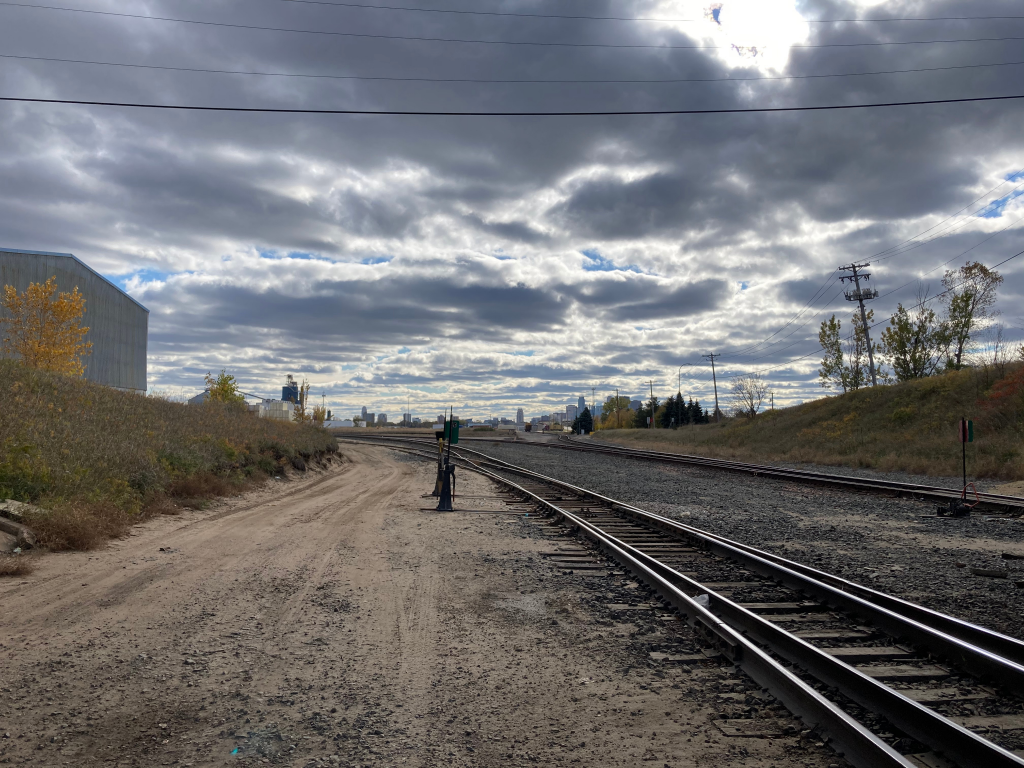
FEATURED ESSAY
An activist investor is leveraging his stake in Canadian Pacific to force the company into climate action, my friend Gudrun Lock tells me. This news overlays our walk through the patchwork of forest, park, and grassland that surrounds the CP-owned Shoreham Yards train and truck site in northeast Minneapolis. The air smells like diesel. We are looking for garlic mustard to harvest for lunch. Behind the property fence, trains arrive and depart. Once a symbol of colonial progress—a world being tamed into a universal program of development and thought—today the trains signify something more uncertain. Amidst the daily fallout of climate chaos and economic stratification and political instability and global pandemics and endless war, much of it linked to violence done in the name of progress, few can still maintain the fantasy. Rail companies have already been transformed by massive reorganizing pressures; today their market strategies respond to the tempos of global supply chains and just-in-time logistics. In many ways, the activist investor’s gambit reflects the next phase of political, economic, and ecological changes that have been underway for decades. Even corporations are being forced to shed the last habits of progress.

What lies on the other side of this upheaval? Clutching our bundles of garlic mustard, Gudrun and I tromp past the Soo Line dump, where railyard junk decomposes and lingers, separated from the soil piled on top by a thin geotextile. Above-ground, the mix of grasses changes bluntly at the dump border. I’ve been struggling to speak clearly about my friend’s project, which convenes a rangy group of collaborators for an art experiment that tracks the busy layers of activity unfolding in and around Shoreham Yards. Maybe the urgent need to hone post-progress praxes provides a way. Together, we collaborators have been sharing what we can glean about the routines shaping trainyard workers’ days; the demands that send container cars full of taconite and fertilizer shuttling between rail, road, and sea; the seasonal shifts of jays and orioles as they flit between power lines and trees; the slow evolution of oak stands giving way to juniper, and the appearances and disappearances of the human encampments sheltering beneath; the unpredictable half-lives of Shoreham’s landfills plus the informal dumps full of neighbors’ mattresses and TVs; the probing paths of deer, foxes, train hoppers, and dogwalkers; the infrastructural armatures of fences, sewers, and buried gas lines; the booms of so-called invasive species and sooty clouds gusting off the flat-graded yard; the fads in corporate-neighborhood relations that have birthed a train-themed playground and buffer pine lines; and on and on. What it all adds up to isn’t simple to say. To think about the trainyard beyond colonial abstractions, a person has to attune to forces playing out at divergent scales of geography and time. This struggle increasingly strikes me as essential. As the anthropologist Anna Tsing observes, the assumption that different scales of activity nest neatly and can be grasped with universally applicable theories is one hallmark of progress logic. Pursuing other ways of knowing might begin with acknowledging the many systems shaping places like Shoreham, while resisting the urge to collapse it all into a single story.


Gudrun and I practice this mode of thinking as we trek on. The dump recedes behind us as we check on the holes that dot the bumpy hill beyond, scattering unsalted peanuts as a one-time offering for the burrow residents: gophers, mice, and what Gudrun thinks might be a badger. She’s been obsessed with the hill’s biggest hole, imagining the colliding pressures that would send a maybe-badger, already living strangely in the nearby golf course or an urban backyard, to flee to Shoreham. Not that the badger is passive; the idea that only humans shape history is another progress falsehood. If the animal is indeed living here in the hill, it is loosening soil as it tunnels, remaking land already terraformed many times over for the trainyard, alongside efforts by microbes, worms, and time. I listen to my friend marking the known and unknown forces at play, mapping the relationship of this encounter to others observed over the course of the project, working to honor the irreducible specificity and complexity of what is emerging. If it’s hard to imagine how this painstaking approach might scale up to inform practical issues of planning and remediation, the consequences of not trying are worse. And perhaps it is here that art — with its conceptual flexibility, embodied practices, and patience for narrative detail — can help. Perhaps projects like The Nature of Shoreham Yards can provide a training ground, an experiment in seeding the kinds of slow, layered, and unpredictably scaled knowledges necessary for living beyond progress.
From inside the trainyard, a semi bleeps a backup warning. Gudrun and I climb the hill, readying ourselves for whatever lies on the other side.
MIRANDA TRIMMIER
MIRANDA TRIMMIER is an essayist who’s made homes in Milwaukee, Minneapolis, New York, and Tucson. Each place shapes her writing, which pays attention to the everyday ways that history lingers in bodies and landscapes. Her work draws on salvaged materials, performance experiments, and an interspecies ethics. She got her MFA from the University of Arizona and has published essays in Places Journal, Terrain, The New Inquiry, Boom California, and other outlets.
Photos within the body of the essay by Gudrun Lock.



